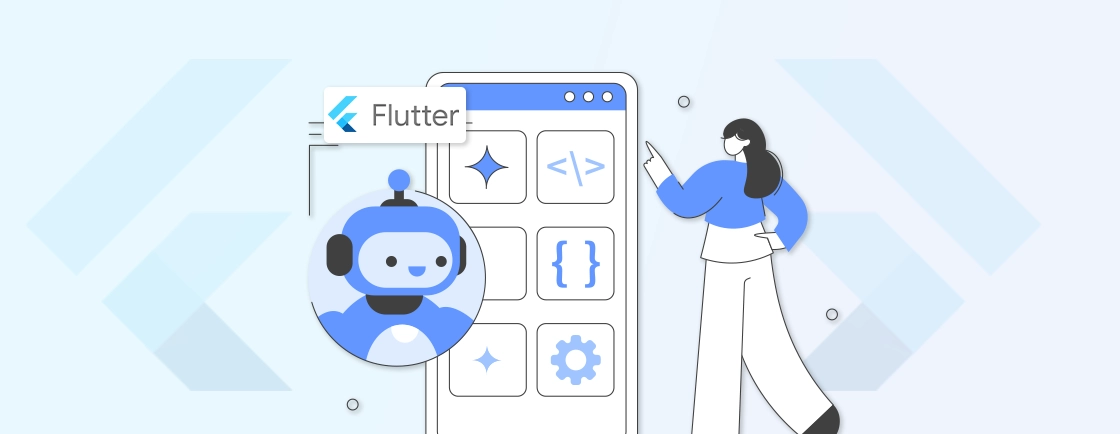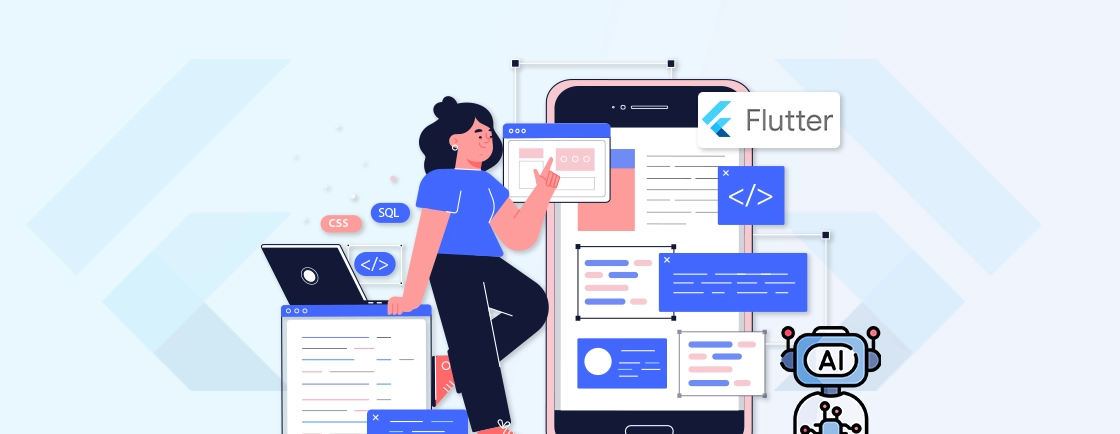Table of Contents
Trying to take your products and services to the maximum number of people around the world? Then what better way to do it other than a mobile app that works across the platforms. A few examples:Google Pay, Google Cloud, Instagram, Facebook, etc. And when it comes to cross-platform app development, one of the best solutions is Flutter.
Flutter lets you build beautiful, high-performance apps with a single codebase. Developers love its hot reload feature for instant updates, along with faster releases and lower maintenance.
Through this blog, we’ll dive deep into the benefits of Flutter app development. And this blog will cover a few drawbacks as well, so you can gain a better perspective. Let’s get straight into it.
Key Features of Flutter
Both Flutter and React Native are among the best mobile app development platforms. And both can help you build a single codebase for multiple operating systems. But Flutter offers a few key, unique features that make it a great choice for the developers:
Hot Reload
Flutter’s Hot Reload lets developers see code changes in real time—without restarting the app. That speeds up debugging, UI tweaks, and feature experimentation, cutting development time significantly. Teams can iterate quickly, maintaining momentum without frustrating delays.
Native Personalization & Internationalization
Flutter doesn’t just translate—it adapts. It offers built-in support for localization, RTL languages, and platform-specific UI behaviors. So the apps feel native to every user. You can adjust layouts for Arabic or fine-tune date formats per region. That ensures a seamless, culturally optimized experience.
Widget Library
Flutter’s rich widget library provides pre-built, customizable components that mimic native controls while allowing limitless creativity. Need a Material Design button or a Cupertino-style switch? Flutter delivers—without platform constraints. The result? Stunning, consistent interfaces across devices.
IDE & Firebase Support
Flutter integrates smoothly with VS Code, Android Studio, and Firebase. You get tools for real-time databases, authentication, and crash analytics. Developers get a unified environment for coding, testing, and deploying—while Firebase handles backend heavy lifting.
Own Rendering Engine
Unlike frameworks relying on native components, Flutter uses Skia to render every pixel. It means buttery-smooth animations, 60fps performance, and identical visuals on iOS and Android—no platform-dependent quirks.
Tooling, Language, & Extensions
Flutter’s ecosystem thrives on Dart (a fast, modern language), CLI tools, and community extensions. Whether automating tests with Flutter Driver or adding plugins for AR, developers have the flexibility to build anything—efficiently.
With Flutter, you can build an MVP or a complex enterprise mobile app with ease. It offers you the tool to deliver fast, scalable, well-designed applications. Utilizing these features to their max can be a little difficult. For that, you can hire Flutter app developers.
Benefits of Flutter App Development
Flutter isn’t just another framework—app developers consider it a game-changer. It combines speed, flexibility, and performance and solves critical pain points for cross-platform apps. Let’s discuss the benefits in detail.
Single Codebase for iOS & Android
Flutter eliminates the need for separate iOS and Android codebases. Write once, run anywhere—while maintaining full native capabilities. This unified approach slashes development time and ensures feature parity across platforms. So your app delivers a consistent experience on every device.
Faster Development & Lower Costs
Flutter offers hot reload, reusable widgets, and a single codebase. It accelerates app development by up to 50% compared to traditional methods. Fewer developers, less maintenance, and quicker iterations mean significant cost savings. That is ideal for startups and enterprises alike.
Native-like Performance
According to Flutter architecture, it compiles directly to native ARM code, bypassing sluggish web views or JavaScript bridges. The results are smooth 60fps animations, instant load times, and hardware-optimized performance. That’s just like a fully native app.
Beautiful, Customizable UI
Flutter’s widget-based architecture gives designers and developers total creative freedom. With it, you can craft pixel-perfect interfaces with custom animations, branded themes, and platform-aware components. That is all while ensuring UI consistency across devices.
Scalability & Flexibility
From MVPs to enterprise-level apps, Flutter scales effortlessly. Its modular architecture allows easy integration with APIs, third-party plugins, and backend services. That makes it simple to add features, support new platforms, or expand globally.
Flutter isn’t just about building apps—it’s about building them better, faster, and for less. With it, you can deliver real business value at every stage–whether you’re just starting out or just optimizing the costs.
Drawbacks of Flutter App Development
Flutter is an excellent platform for building your mobile app–but of course, like every other platform, there are some drawbacks. You need to understand them along with the benefits to evaluate if Flutter is suitable for you. So let’s look at the drawbacks of Flutter app development.
Limited Native Functionality – Bridging the Gap Takes Effort
While Flutter covers most use cases, highly specialized native features (like advanced Bluetooth or AR tools) may require custom platform-specific code. Developers often need to write channel integrations to access certain iOS/Android APIs, adding complexity.
Bulkier Than Native Alternatives
Flutter apps tend to be larger in size compared to pure native apps due to the bundled engine and widgets. A simple “Hello World” app can start at ~5 MB+, which may impact download rates in regions with slow internet.
Young Ecosystem (Fewer Mature Libraries)
Though growing fast, Flutter’s library ecosystem lags behind native platforms in some areas. Niche functionalities might require in-house development or reliance on less-tested third-party packages, increasing project risk.
Not Ideal for Heavy Graphics or Gaming
While fine for most UIs, Flutter isn’t optimized for graphics-intensive apps (e.g., 3D games or complex simulations). Engines like Unity or Unreal remain better choices for high-performance rendering.
Dart Language Has a Smaller Talent Pool
Flutter uses Dart, which—despite being easy to learn—has fewer developers than JavaScript or Swift/Kotlin. Hiring experienced Flutter developers can be more challenging, especially outside major tech hubs.
Platform-specific Nuances
Flutter ensures UI consistency. But platform-specific behaviours (e.g., scrolling physics, navigation gestures) sometimes require manual adjustments to feel truly native.
Flutter excels in speed and cost-efficiency, but these trade-offs matter for highly specialized or performance-critical apps. To that end, you can consult our Flutter development company. We will analyze your app requirements and use this platform to the best of its abilities.
Popular Apps Using Flutter
Flutter isn’t just for startups—major tech giants, Fortune 500 companies, and industry leaders rely on it for high-performance and cross-platform development. Let’s discuss the top apps built with Flutter.
Google Pay
Google rebuilt its flagship payment app with Flutter to unify iOS and Android experiences while accelerating feature rollout. The result? A fast, consistent UI with smooth animations—handling millions of transactions daily.
Flutter’s hot reload was critical for rapid iteration in a regulated fintech environment.
Google Earth
Flutter powers Google Earth’s interactive UI, enabling cross-platform accessibility without sacrificing performance. The framework offers the ability to handle complex, data-rich visuals while maintaining 60fps. That made it ideal for this global mapping tool.
My BMW App
BMW’s My BMW App uses Flutter to deliver a premium, brand-consistent experience across mobile and web. The team reduced development time by 30%. And it achieved pixel-perfect UI alignment with BMW’s design language.
eBay Motors
eBay Motors app (for car enthusiasts) relies on Flutter’s quick iteration cycles to test and deploy new features. The app handles high-resolution vehicle galleries and real-time bidding without compromising on speed.
Philips Hue
Flutter enables Philips Hue’s cross-platform app to sync seamlessly with smart home devices. The framework’s real-time UI updates were crucial for creating dynamic lighting scenes that respond instantly to user input.
Xiaomi
Xiaomi uses Flutter in its Mi Home app to manage IoT devices across 190+ countries. The single codebase simplified localization and updates. That ensures a uniform experience for Xiaomi’s global user base.
From fintech to automotive and IoT to shopping, Flutter is the foundation to a variety of mobile apps. It proves Flutter’s versatility at scale.
Let’s Conclude
Flutter has proven itself as more than just a cross-platform framework. It’s a game-changer for businesses and developers alike. With Flutter, you get native-like performance, a single codebase, and rapid development cycles. So there are no traditional trade-offs between speed, cost, and quality.
Flutter may not replace every native use case. But its advantages in time-to-market, maintainability, and UI control make it an unbeatable option for more apps.
FAQs on Benefits of Flutter
Is Flutter’s performance comparable to native apps?
Yes. Flutter compiles to native ARM code, runs at 60fps, and uses its own rendering engine for smooth, lag-free UIs.
Can Flutter reduce app development costs?
A shared codebase means fewer developers, faster iterations (thanks to hot reload), and easier maintenance. It can cut expenses by up to 40-50%.
Can Flutter apps have custom UI designs?
Absolutely. Flutter’s widget-based system allows fully customizable, pixel-perfect interfaces—without platform limitations.
How easy is it to update a Flutter app?
It offers Hot Reload to push updates in real time. And Firebase simplifies backend updates without app store delays.
Does Flutter work well with IoT and hardware devices?
Yes, but Bluetooth, NFC, or specialized hardware access may require platform channels to bridge native code.
Accelerate Development with Flutter
Build high-performance mobile, web, and desktop experiences from one unified Flutter codebase.




